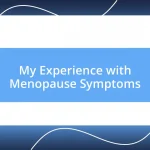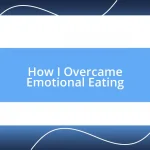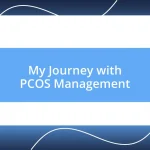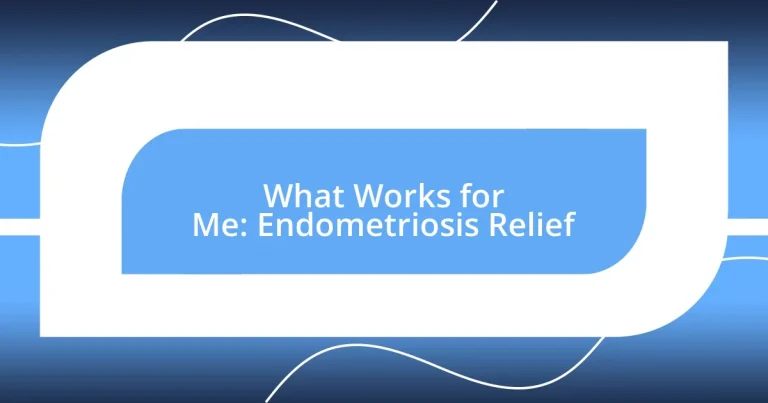Key takeaways:
- Understanding the varied symptoms of endometriosis, including pain, fatigue, and gastrointestinal issues, is crucial for effective management.
- Making lifestyle and dietary adjustments, such as a balanced diet and regular exercise, can significantly alleviate symptoms and improve overall well-being.
- Coping strategies for mental health, including mindfulness practices and support groups, are essential for managing the emotional impact of living with endometriosis.
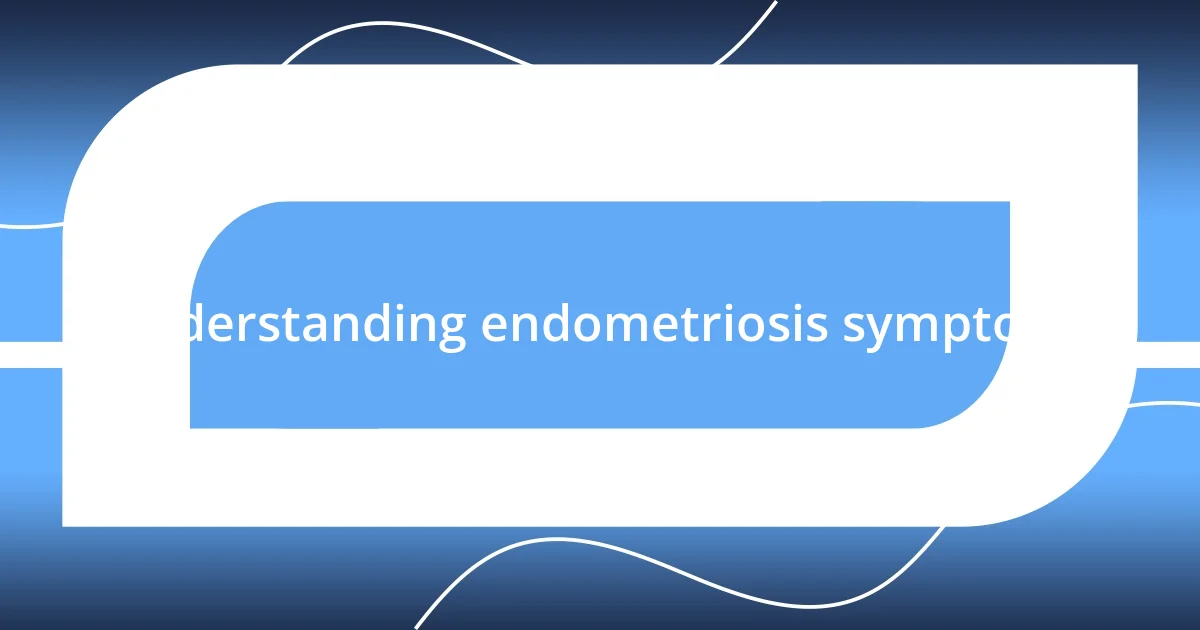
Understanding endometriosis symptoms
Understanding the symptoms of endometriosis is crucial for anyone experiencing this condition. For me, the cycle of pain started well before my diagnosis; I remember thinking, “Is it supposed to hurt this much?” The discomfort wasn’t just limited to intense cramps during my period; it felt like a dull ache that lingered every day, making me question my limits.
Many people often underestimate how varied endometriosis symptoms can be. It’s not just about the pain—I’ve had moments of extreme fatigue that felt all-consuming, almost like wading through molasses in a fog. I often wondered if anyone else felt the sheer exhaustion that came without warning, robbing me of joy and focus. Seeing a friend breeze through her day without the shadow of fatigue made me feel isolated in my struggles.
Moreover, gastrointestinal issues like bloating and irregular bowel movements can accompany the condition, often turning a simple meal into a game of roulette. I distinctly recall a family dinner where I could barely enjoy the food because of the crippling discomfort in my abdomen. Have you ever felt like your body was betraying you in such a public moment? Those experiences made me acutely aware of how endometriosis isn’t just a female health issue; it’s a condition that shapes our everyday lives in profound ways.
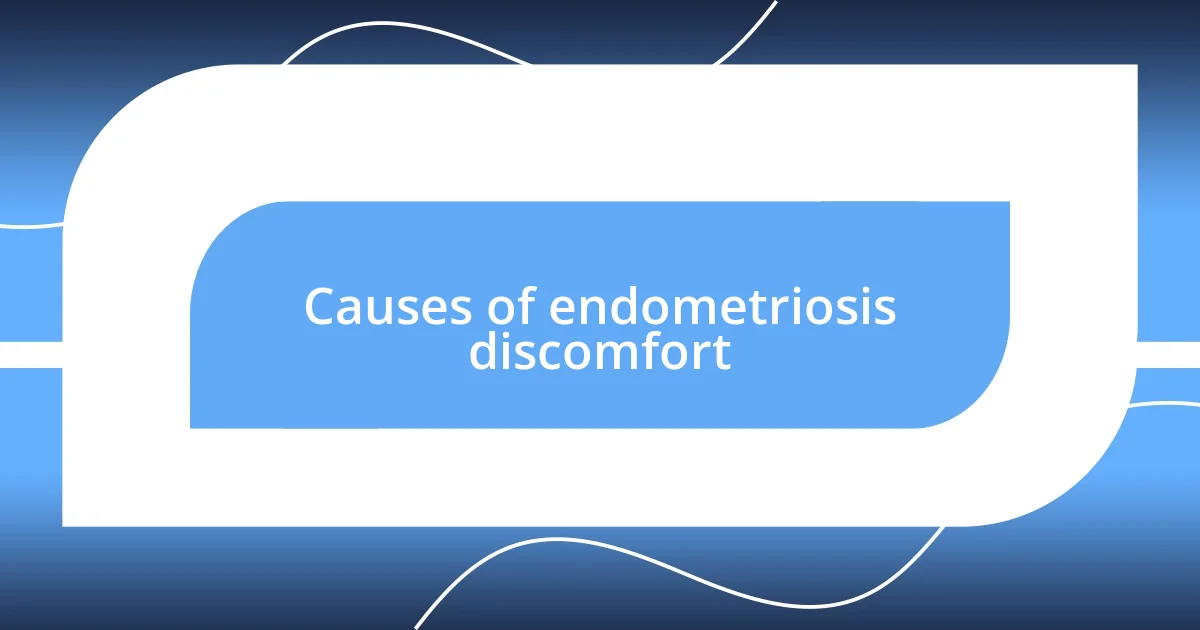
Causes of endometriosis discomfort
The discomfort associated with endometriosis can largely stem from the growth of tissue similar to the uterine lining outside the uterus. I remember the first time I learned about this process; it felt like a lightbulb went off in my head. The tissue sheds and bleeds during my menstrual cycle just like it would within the uterus, but there’s no way for it to exit the body. Instead, it can lead to inflammation, scarring, and painful adhesion, creating a chaotic internal environment.
Hormonal fluctuations play a significant role in amplifying discomfort as well. I often found myself wishing I could just control how my body responded to my cycles. The surge in hormones, particularly estrogen, tends to worsen the pain. During my worst days, I felt like a marionette pulled by unseen strings, with each cramp and spasm a reminder of my body’s relentless struggle.
Finally, the psychological impact of living with endometriosis shouldn’t be overlooked—it’s a constant battle between mind and body. I can’t count the number of times anxiety crept into my thoughts, especially when facing social situations during my flare-ups. I still recall the stress of having to explain my sudden absences or why I was unable to commit to plans. It’s a reminder that while this condition affects our bodies, it also affects our overall well-being.
| Cause | Description |
|---|---|
| Endometrial Tissue Growth | Tissue similar to the uterine lining grows outside the uterus, causing inflammation and pain. |
| Hormonal Fluctuations | Changes in hormone levels, particularly estrogen, exacerbate symptoms and pain levels. |
| Psychological Factors | Living with endometriosis can lead to anxiety and stress, compounding the physical discomfort experienced. |
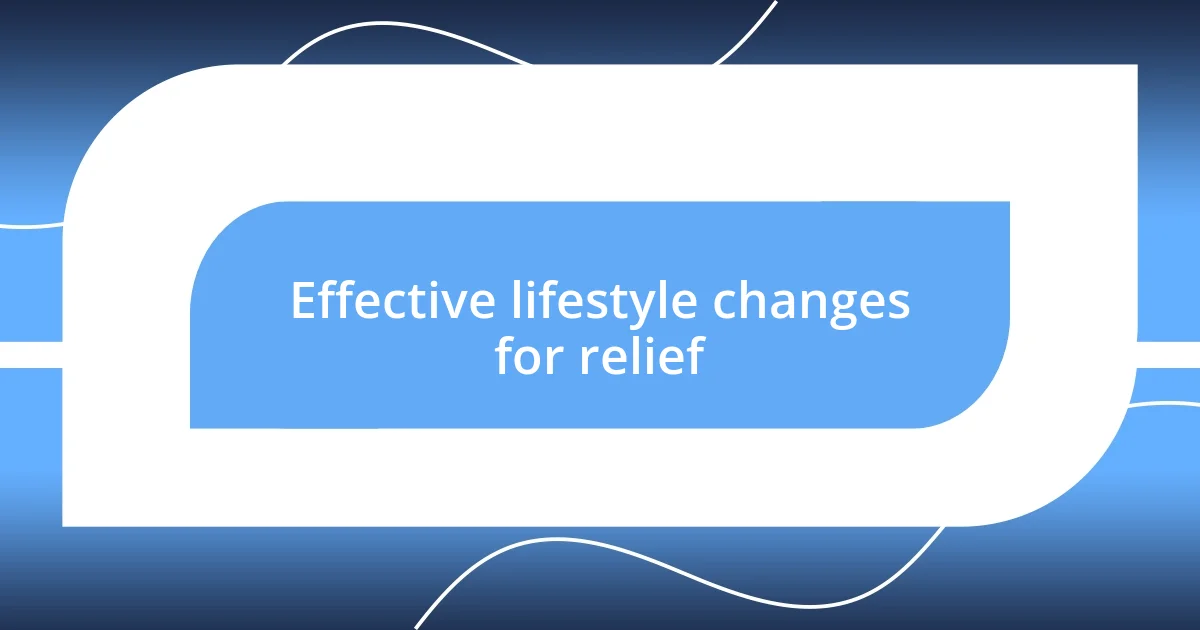
Effective lifestyle changes for relief
Making effective lifestyle changes can be a game-changer in managing endometriosis symptoms. I remember when I first shifted my focus to nutrition; the impact was both surprising and empowering. Incorporating a balanced diet rich in anti-inflammatory foods, such as leafy greens, berries, and omega-3 fatty acids, genuinely made a difference in how I felt day to day. It’s fascinating how what we put into our bodies can influence our wellness—like nourishing our inner selves.
Here are some effective lifestyle changes I’ve found helpful:
- Regular Exercise: Engaging in gentle activities like yoga or swimming helps alleviate tension and improves mood.
- Stress Management: Techniques like meditation and deep-breathing exercises can reduce the intensity of flare-ups.
- Quality Sleep: Prioritizing sleep can significantly enhance energy levels and overall well-being.
- Hydration: Drinking plenty of water not only helps manage bloating but also supports digestive health.
- Mindful Eating: Paying attention to food triggers while eating mindfully can minimize gastrointestinal symptoms.
Incorporating these changes into my routine took time and patience, but I can honestly say it was worth every effort. I vividly recall a moment where I attended a gathering, and instead of being desperate for comfort, I felt lighter and more in control—an instance that filled me with hope.
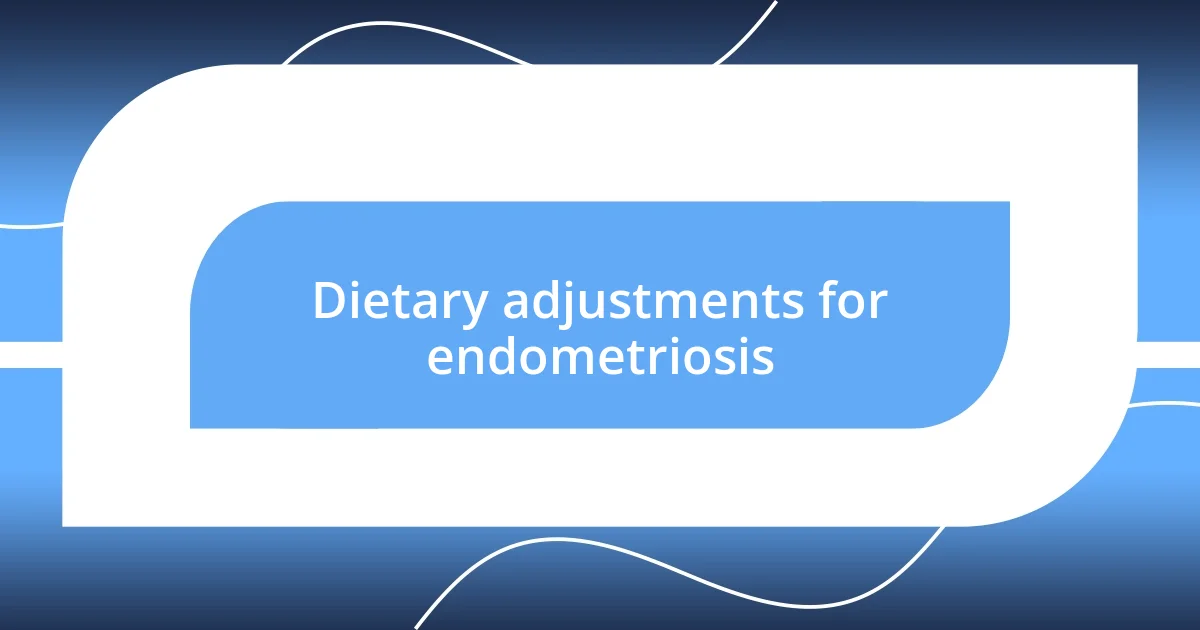
Dietary adjustments for endometriosis
Dietary adjustments can significantly influence how we experience endometriosis. I remember when I first eliminated gluten from my diet; the change was almost immediate. It’s remarkable how some foods can agitate the body and create chaos in our systems. By replacing processed foods and refined sugars with whole, nutrient-dense options like quinoa, nuts, and fresh fruits, I felt a noticeable reduction in bloating and discomfort. Have you ever experienced that sense of clarity when you simply stop putting the wrong things into your body?
In my quest for relief, I stumbled upon the benefits of anti-inflammatory spices such as turmeric and ginger. These natural powerhouses not only enhance flavor in meals but also calm the inflammation that can accompany endometriosis. I distinctly recall a moment while cooking a turmeric-infused soup when it hit me: nourishing my body can be a form of self-care. There’s something incredibly empowering about taking control of my diet and, in turn, my symptoms.
Focusing on a diet high in fruits, vegetables, and healthy fats has been a transformative experience for me. I also learned to pay attention to food sensitivity signs—like noticing how dairy sometimes triggered my symptoms. It made me wonder, what if our bodies are trying to communicate with us through these reactions? Each meal is an opportunity to listen and respond in a way that supports not just my health, but my well-being.
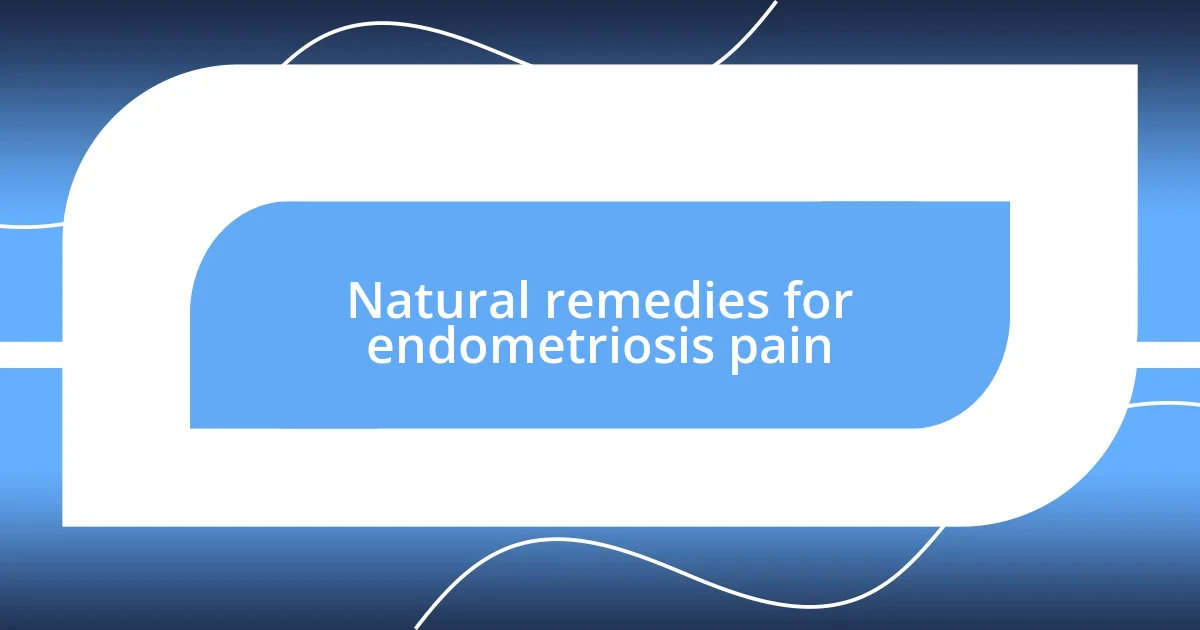
Natural remedies for endometriosis pain
Exploring natural remedies for endometriosis pain has been a journey for me, one filled with discovery and self-care. I’ve turned to herbal teas like chamomile and peppermint, which not only soothe but also provide a sense of comfort during flare-ups. Have you ever found solace in a warm cup of tea? It’s that simple act of pausing, sipping, and breathing deeply that often helps me unwind.
One of the most surprising remedies I stumbled upon was the power of essential oils. Lavender and clary sage became my go-to allies, as I learned to use them for relaxation and pain relief. The first time I diffused lavender oil in my room, I felt an overwhelming sense of calm wash over me, almost as if the chaos inside me was gently easing away. It’s incredible how aromatherapy can support our well-being, right? I’ve found that just a few deep breaths with these oils can make a significant difference in my mood and pain levels.
Another remedy that resonates with me is the practice of acupuncture. My first session left me feeling like I had tapped into some untapped energy within. While it may seem unconventional, the gentle needles combined with the serene environment truly brought relief to my pain. I wondered then, how many of us overlook holistic methods that have been used for centuries? With each treatment, I’ve felt a shift—a reminder that there are pathways to healing beyond traditional medicine.
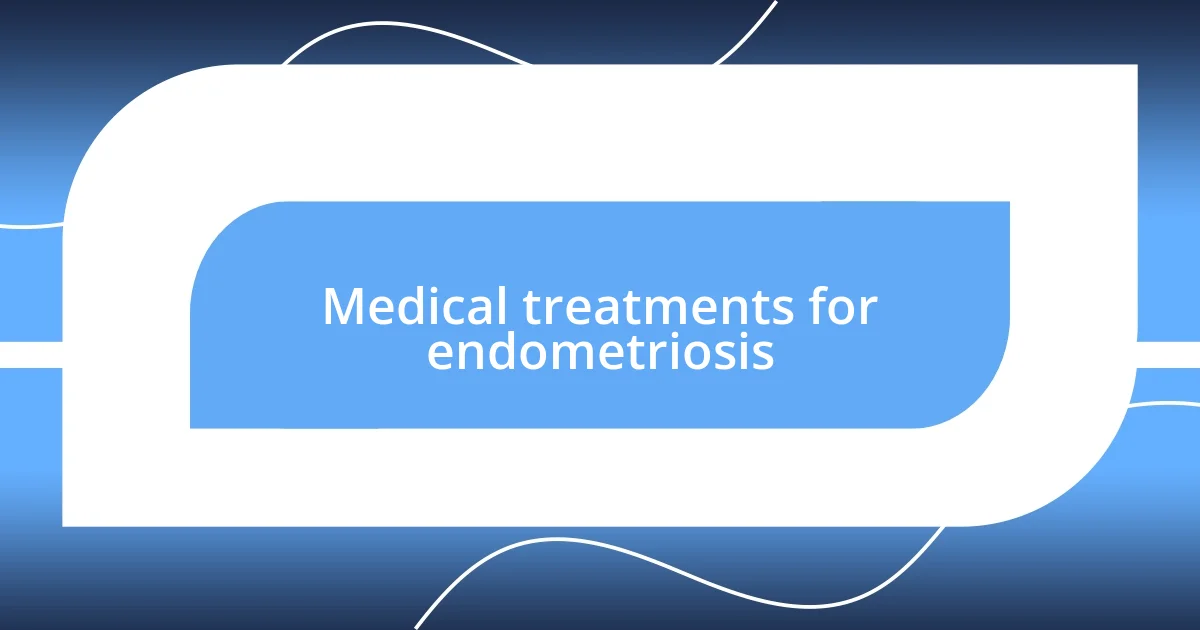
Medical treatments for endometriosis
I’ve learned that medical treatments for endometriosis can be both a source of hope and a bit daunting at times. When I first discussed hormonal therapy with my doctor, I felt a mix of relief and anxiety. Would this be my go-to solution? It turns out that treatments like birth control pills and hormonal IUDs can significantly reduce pain for many, addressing those pesky symptoms directly. But it made me think—do we fully understand how our bodies react to these interventions?
Another medically guided option that caught my attention is laparoscopic surgery. The first time I heard about it, I was fascinated by the idea of removing endometrial tissue, yet I felt intimidated by the surgical aspect. However, hearing stories from friends who experienced a marked improvement post-surgery motivated me to consider it carefully. It’s a reminder of how impactful medical expertise can be in our journey toward relief, though I still wonder how each individual’s path differs.
Finally, there’s the option of GnRH agonists to explore, which truly had me curious about the spectrum of treatment. When I learned that they can help manage symptoms by inducing a temporary state similar to menopause, it instantly sparked mixed feelings—could reaching that point be beneficial or overwhelming? In my experience, involving a healthcare professional in this conversation is crucial, as each treatment comes with potential side effects. It’s a balancing act, weighing what might work best for us personally, don’t you think?
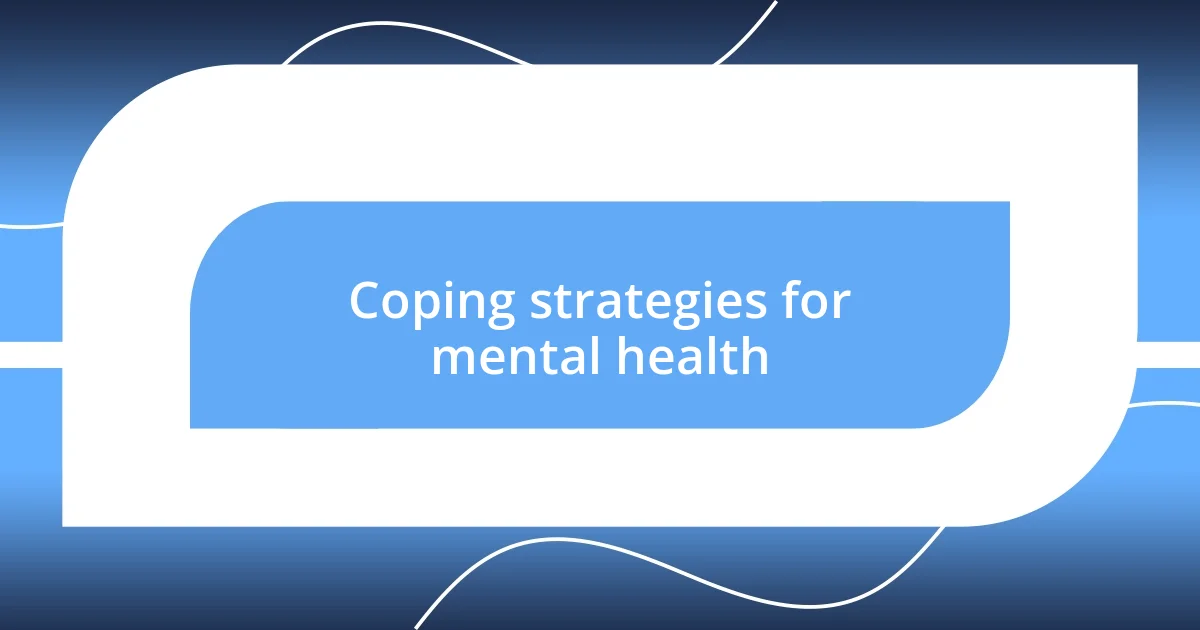
Coping strategies for mental health
Coping with the mental health toll of endometriosis is something I’ve learned to approach with care and compassion. I remember a particularly tough week when the pain seemed relentless, and I felt a wave of despair wash over me. It was then that I began journaling my thoughts and feelings. Putting pen to paper allowed me to process my emotions, almost like having a conversation with myself. Have you ever tried journaling? It can be an empowering release, transforming overwhelming feelings into tangible words on a page.
Mindfulness and meditation have also played a pivotal role in my journey. I can’t forget the first time I sat in a quiet room, focusing solely on my breath. I was surprised at how quickly my mind wandered, but gently guiding it back felt like an act of self-love. Integrating just a few minutes of mindfulness each day has helped me cultivate a sense of awareness and presence that’s grounding, even amidst the chaos of chronic pain. Isn’t it fascinating how such a simple practice can help us tune in to our own emotional landscape?
Additionally, connecting with others who understand the struggle has been invaluable. I joined a local support group, stepping into a room filled with women who shared their stories and laughter despite the pain. I’ve felt a profound sense of belonging there. It made me realize the power of community; sometimes, just knowing you’re not alone can lift that heavy weight off your shoulders. Isn’t it comforting to think that we can support each other through these challenges?




